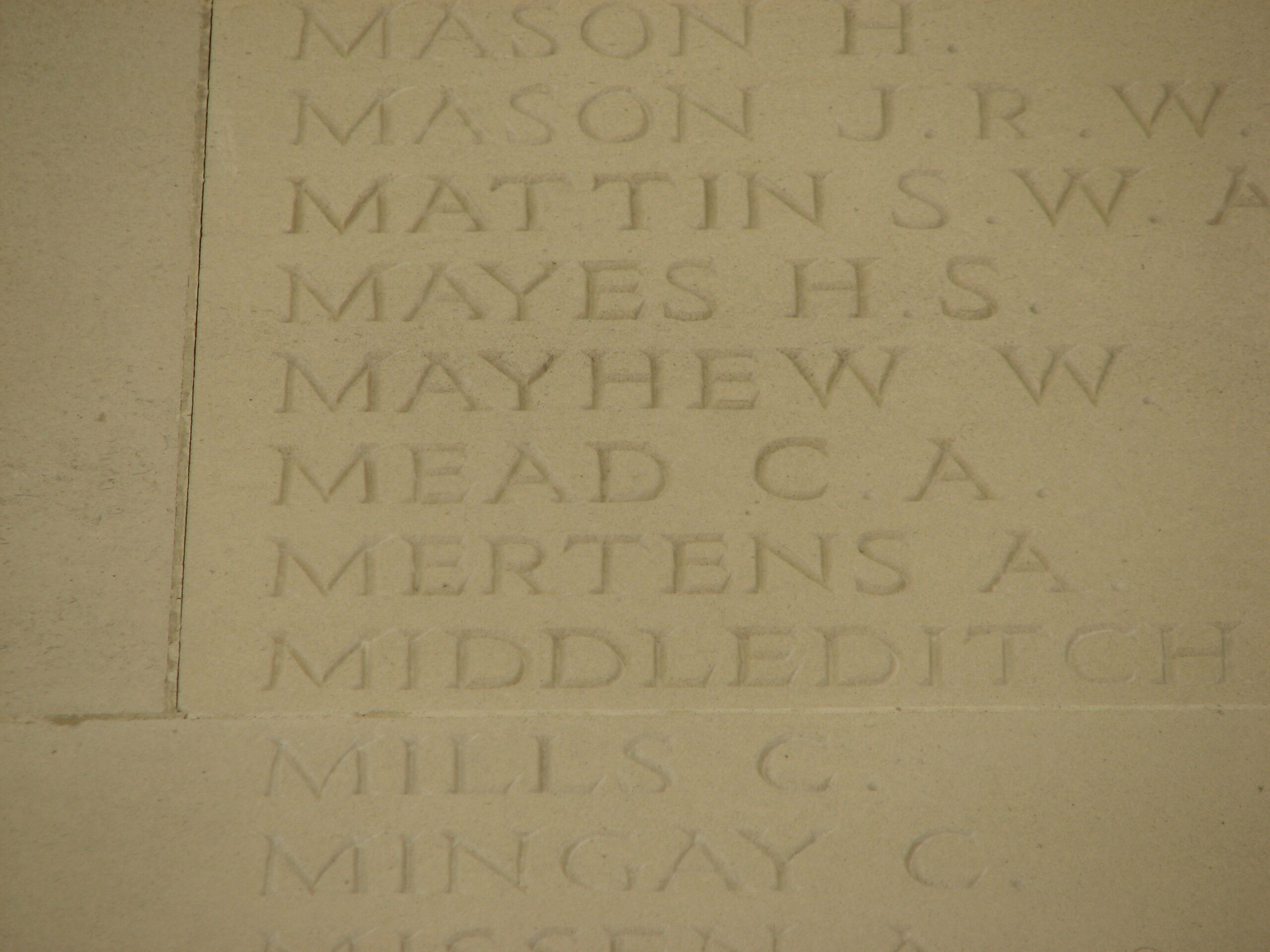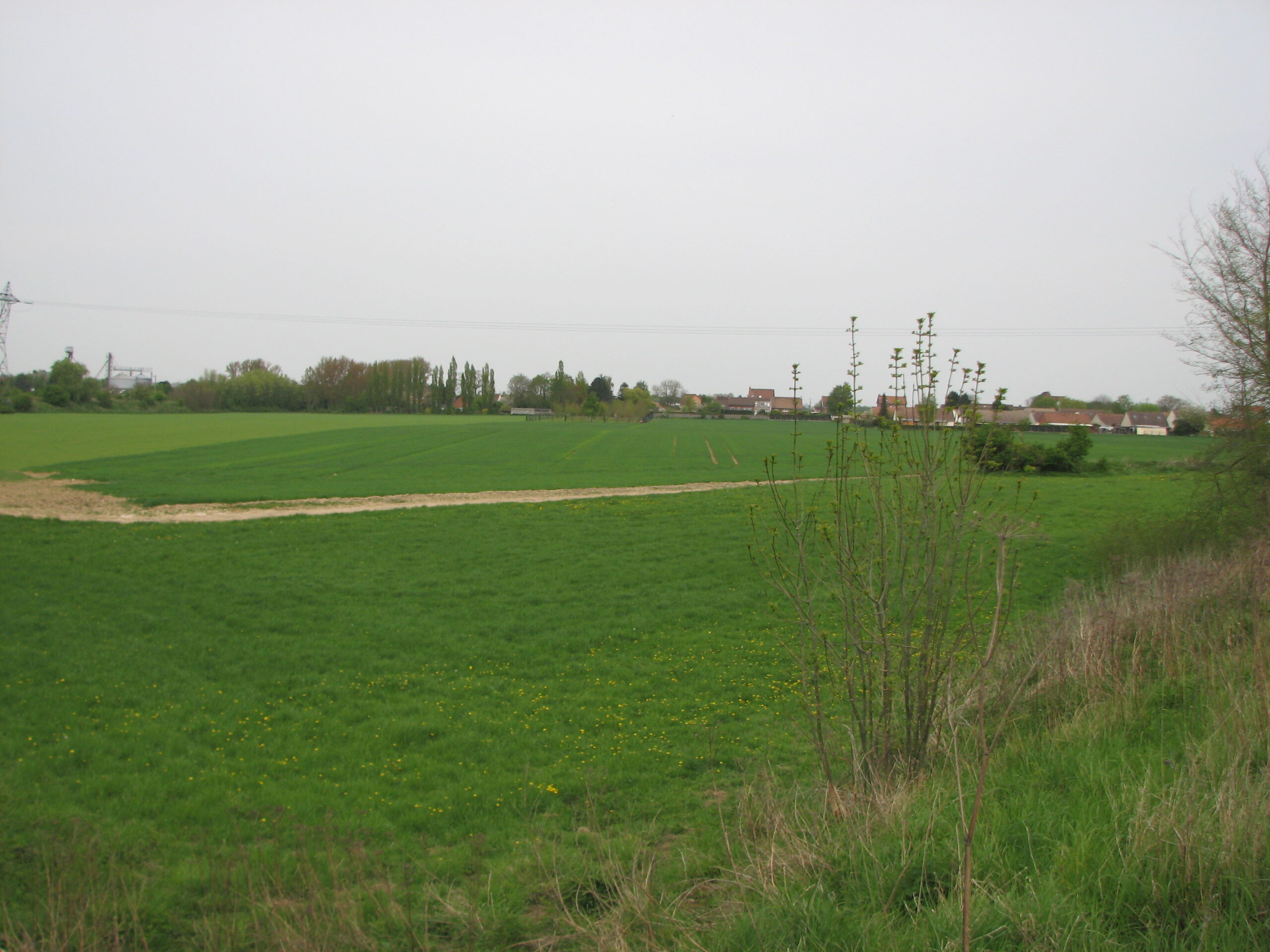Charles Mead (1892 - 1917)
Charles served in France with the 11th Battalion of the Suffolk Regiment. He was killed during the Battle of Arras in April 1917 and has no known grave.
- 44
- Died in the Great War
- 51.975892, 1.013971
Details
| Name: | Charles Arthur Mead |
| Service: | British Army |
| Unit: | 11th Battalion, Suffolk Regiment |
| Regimental Number: | 24166 |
| Rank: | Private |
| Date of Death: | 28th April 1917 |
| Age: | 24 |
| Commemorated: | Bay 4, Arras Memorial, Arras, France. |
Family Background and Early Life
Charles Arthur Mead was born in East Bergholt on 19th November 1892, the only child of Charles and Alice Mead.
Charles Henry Mead – or Harry, as he was often known – was originally from Thorrington, near Brightlingsea, and at the time of his son’s birth was employed as a Gardner and Domestic Servant. Harry had married Esther Alice Webber (usually called Alice) who was from Boxted, in 1891; they moved to East Bergholt shortly afterwards.
The younger Charles started at the village school on 8th June 1896, at which time his family were living in the centre of the village at the Courtyard, (or The Court as it is now called). By April 1901, the family had moved to The Street, where they lived for at least the next 10 years. 1 At some point between 1911 and the 1920’s, Harry and Alice moved to a house called The Rosary on Elm Road, where they lived for the rest of their lives. It is not known at the present time whether this move took place whilst Charles still lived with them.
Harry expanded on his gardening work, by starting a Greengrocer’s in the village. After Charles left school in March 1905, he was employed by his father in the family business. 2 Harry Mead’s Greengrocers shop stood near to the present site of Aldous Close (source, the late Mrs A. De’Ath).
The Group Scheme
Charles appears to have joined the British Army under the Group Scheme in late November or early December 1915. 3 The Scheme was commonly called the Derby Scheme after Lord Derby, the Director-General of Recruiting. It was effectively a last ditch attempt by the government to increase recruitment by voluntary means, before they had to resort to conscription. It seems likely that he formally enlisted and joined the Army Reserve, but as permitted under the terms of the Scheme, he then chose to go back to his civilian occupation until he was required.
It seems that Charles may have been called up in January 1916. Unfortunately, Charles’ Army Service Record does not survive, so we cannot know for sure exactly when he was sent to France, or when he joined the Suffolk Regiment’s 11th Battalion. However, evidence strongly suggests that he was sent to France in either June or July 1916, and joined the 11th Suffolks in July.
Battle of the Somme and Bois Grenier
The 11th were a Service Battalion, and had been in France since January 1916. 4 To allow for the influx of new recruits in the late summer and early autumn of 1914, following Lord Kitchener’s call for volunteers, the Suffolk Regiment (like many other regiments) had created additional battalions. These new battalions were called “Service Battalions” and were raised specifically for the duration of the War. At the time that Charles most likely joined them, they were refitting and training, after suffering heavy losses in the opening days of the British offensive now called the Battle of the Somme, at the start of July. 5 To help replace the losses that they had suffered at the start of the Battle of the Somme, between 5th and 30th July 1916 the Battalion received reinforcement drafts totalling 13 officers and 530 Other Ranks.
The 11th Suffolks returned to the Battle at the end of July and suffered over 150 casualties in the fighting around the villages of Bazentin-le-Petit and Bazentin-le-Grand.
After being relieved in mid-August, the Battalion left the Somme sector and were transferred north to Bois Grenier, south of Armentieres, near the Belgian border. When taking their turn in the line, the Battalion remained in this area until the end of January 1917. Compared to the Somme, it was relatively quiet, though casualties still occurred.
In February, the Battalion were moved to the rear and began a period of training that was to last until mid-March, when they were moved to the front at Arras.
Battle of Arras
What has become known as the Battle of Arras began primarily as part of a joint offensive with the French. The British Army were to attack on an eleven mile front close to the town of Arras, whilst the French offensive took place 45 miles to the South.
The British offensive was launched on 9th April 1917, and started very successfully with significant British gains. Unfortunately, the promise of the first few days did not last, though the Battle ground on until 16th May. 6 Though little known today, in terms of average daily casualties the Battle of Arras was the most lethal offensive battle fought by the British Army during the Great War.
The 11th Suffolks took part in the fighting of the first four days of the Battle, taking their objectives but suffering substantial casualties in the process. They again moved up to the front line on 24th April, this time to a position facing the fortified remains of an agricultural chemical works in the village of Roeux.
Roeux – situated approximately 4.5 miles to the east of Arras, in the valley of the River Scarpe – was one the fortified villages that formed part of the German defences behind their front line. Three previous attempts to capture it had failed, each time with heavy casualties.
At 4.27 a.m. on 28th April 1917, following a heavy bombardment, the 11th Suffolks – forming the left battalion of 101st Brigade – attacked the Chemical Works. The Battalion was soon halted, and then driven back by intense machine gun fire from blockhouses, bunkers and tunnels. A strong German counter-attack later in the morning recaptured most of any earlier British gains, and at 10 o’clock that night the Battalion was temporarily withdrawn to the support-line trenches.
Approximately half of the 11th Suffolks had become casualties during the failed attack, including 106 who had been killed. Charles was one of the dead. footnote] Another of the 11th Suffolks killed during the attack on Roeux, was 31 year old Frederick Richer, who lived near St. Michael’s Church in Brantham. Frederick was buried in Roeux British Cemetery. The exact location of Frederick’s grave is no longer known, as the marker was later destroyed by shellfire, so he is now commemorated on a special headstone within the Cemetery.[/footnote]
Charles has no known grave, and is officially commemorated on the Arras Memorial. This Memorial to the Missing contains the names of over nearly 35,000 servicemen from the United Kingdom, South Africa and New Zealand, who died in the Arras sector between the spring of 1916 and 7th August 1918, and have no known grave.
Postscript
Alice Mead died in August 1946 at the age of 81 and Harry died in 1958 at the age of 91. Both are buried in the village cemetery.
Copyright © Mark Ashmore, 2024
- 44
- Died in the Great War
- 51.975892, 1.013971



